During your trip to Rome, you must visit the Colosseum. It’s a UNESCO World Heritage Site and the largest surviving monument of Ancient Rome, attracting millions of visitors every year. Also known as the Flavian Amphitheatre, during Roman times, it was the stage for great public spectacles such as gladiator fights and executions. Today, however, to visit the Colosseum, you need to plan your visit in advance to find tickets and secure access. In this article, I explain what to see and share my tips for maximising your experience.
Table of Contents
What you need to know about the Colosseum before visiting
Built between 70 and 80 AD at the behest of Emperor Vespasian, the Colosseum is the largest Roman amphitheatre, with a capacity of about 50,000 to 87,000 spectators. Originally known as the Flavian Amphitheatre, it was financed by the dynasty of emperors Vespasian, Titus and Domitian. At the time, it was taller and covered with marble. The shows inside were gladiator fights, animal fights, and public executions.
PLAN YOUR TRIP TO ROME
Save money on entrance fees and transportation costs with the Roma Pass. This City Card offers free entry to two attractions, as well as discounts at other museums and archaeological sites, including the Colosseum, the Roman and Imperial Forums, the Capitoline Museums, the Ara Pacis and other must-see.
To stay connected in Italy, remember to buy an Airalo eSim online, with data and phone coverage for your trip to Rome.
Why it is called Colosseum
The original name of the famous monument was Anfiteatro Flavio because Flavian emperors Vespasian, Titus and Domitian built it. Over the centuries, however, the Roman people began to call it Colosseum, from the Latin adjective colosseum, meaning colossal. They referred to the size of an enormous bronze statue of Nero in front of the amphitheatre. Apparently, the statue was almost as tall as the Colosseum itself and much better known than the Flavian Amphitheatre.
The fights of the gladiators
The Colosseum offered an intense calendar of shows and public events. For its inauguration, Emperor Titus gave games that lasted three months. The spectacles followed one another according to a pre-established list. The fights between animals or between gladiators and animals were in the morning, the death sentences at lunchtime and the gladiator fights in the afternoon.
The gladiators were professional fighters who lived and trained inside the ludi, buildings run by an impresario who provided his men with food, accommodation, and training. Each gladiator had his own speciality and fought, on average, only twice a year. Not all gladiators were prisoners; many pursued this career for popularity or money.
The Christian Colosseum
If today you see a cross inside the Colosseum, it is because, in 1744, Pope Benedict XIV had it exorcised and consecrated to the passion of Christ and all the saints. Besides the cross, he also had the 14 aedicules of the Via Crucis built around the arena’s perimeter.
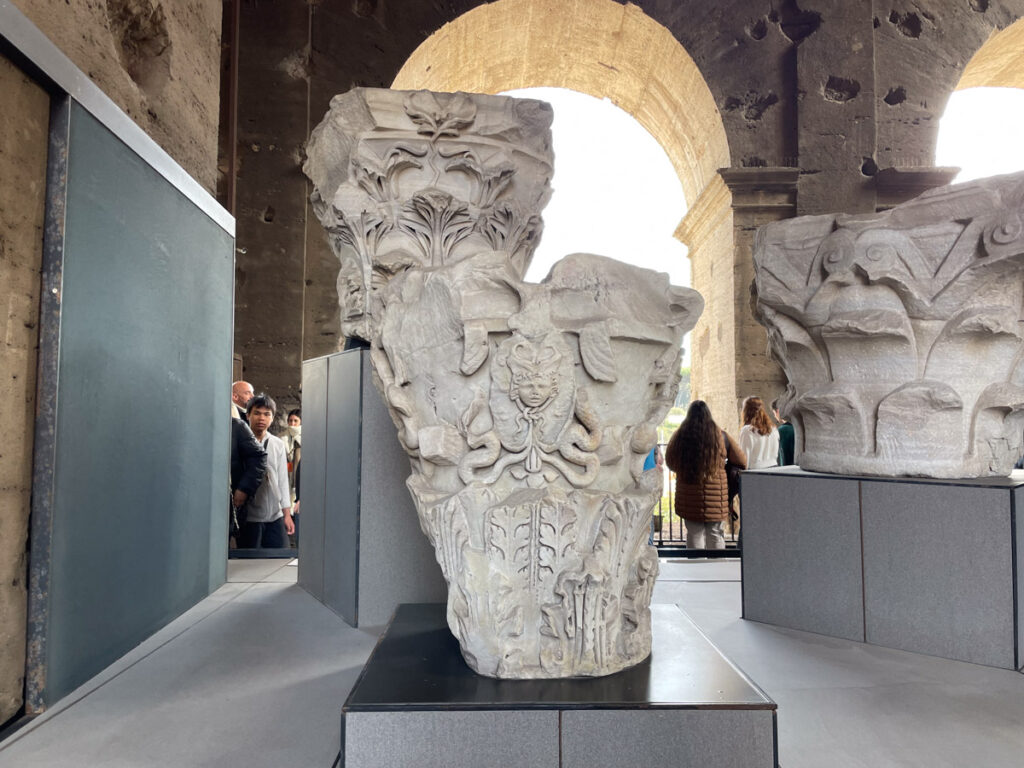
The Architecture of the Colosseum
The architecture of the Colosseum still dominates the heart of Rome with its imposing presence even after millennia of history and change. Divided into three levels, the monument features a series of arches and columns that testify to the Romans’ skills in the engineering field.
Like all amphitheatres, the Colosseum has an oval layout, with tiers stacked around the central arena. Much of the outer ring fell over the centuries. Still, you can see the entrance arches where spectators entered according to a precise social hierarchy, with the emperor in the place of honour and women in the worst seats. Thanks to excavations in the 1930s, today you can also see the underground part of the corridors through which gladiators, animals and service personnel passed during the spectacles.
The facade of the Colosseum
The best way to visit the Colosseum is to admire its exterior façade before entering. You can walk around it to admire it from all angles. You will undoubtedly notice that the Flavian Amphitheatre has architectural elements in different styles: one older and one more recent, related to the restorations carried out in the last centuries.
During the Middle Ages, many of the travertine marble that covered it were removed. They were reused in the construction of churches or other buildings in Rome, a common practice during the rule of the Papal States. The holes visible along the façade were the metal hooks that supported the marble slabs. This spoliation weakened the structure of the Colosseum and the years and earthquakes led to several collapses. The buttresses that are now part of the architecture of the Flavian Amphitheatre are later additions to stabilise the structure.
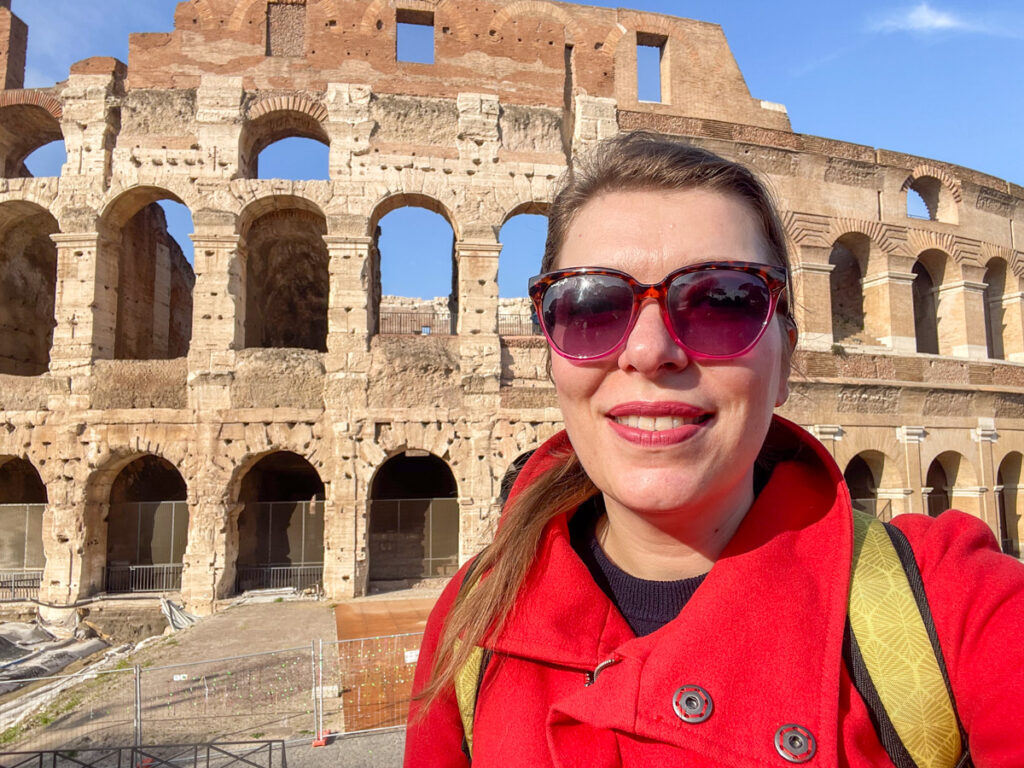
The 19th century restorations
The Colosseum you can see today bears the signs of time and the restorations that took place over the centuries. During the Middle Ages, it was used as a quarry for new building materials. At the same time, the earthquakes that struck the city caused significant damage, such as collapses to an already weakened structure.
One of the first significant restorations was by architect Raffaele Stern in the 19th century. He consolidated the structure of the Colosseum by walling up some of the arches and inserting a diagonal brick wall to support the outer ring, which had partially collapsed over time.
Later, architect Giuseppe Valadier built a buttress in brick and travertine to support the outer ring, followed by the reconstruction of the destroyed arches, performed “by analogy”, faithfully reproducing the original shapes, styles and materials. For this reason, it isn’t easy today to distinguish the authentic parts from the restored ones, except for slight colour differences.
Finally, Gaspare Salvi completed the restoration by adding a buttress on the southern side of the building, similar to Stern’s, thus helping preserve the Flavian Amphitheatre’s structural integrity.
The Colosseum arena and the tiers of seats
The Flavian emperors officialy built the Colosseum as a gift for the Romans. However, the building had the political purpose of showing the wealth and importance of the Roman Empire. The arena was the stage for incredible spectacles, such as gladiator fights, animal games and theatrical performances. The Colosseum was accessible to all citizens, free of charge.
Today, during your visit, you can see the Colosseum arena from different perspectives, walking on the steps. The access to the Flavian Amphitheatre was carefully designed, with 76 entrances that made it much smoother than today. The different tiers offered seating divided by social class. The first tier was for the emperor, his family and senators, with the seats closest to the arena.
The second level was for the wealthy class, while the third, now considered the best for memorable photo opportunities, was for the people. The second level houses an exhibition on the history of the Colosseum, but it can be very crowded. During my visit, for example, I could not see anything, so many people were there.
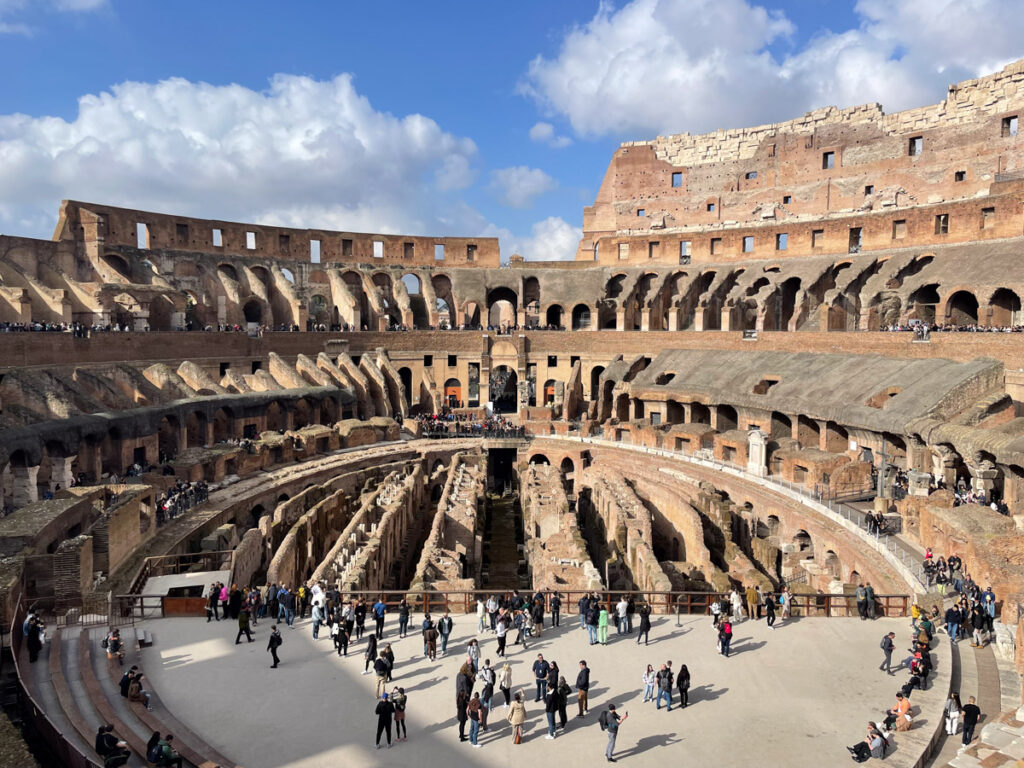
The Colosseum Archaeological Park: Palatine Hill and Imperial Forums
The Colosseum is part of the Colosseum Archaeological Park. The ticket also includes the Palatine Hill and the Imperial Forums. The Palatine Hill is one of the seven hills of Rome, where legend has it that Romulus founded the city. At its foot are the Imperial Forums, a complex of buildings that formed ancient Rome’s political, religious, and commercial heart.
Over the centuries, the Roman Forum was the site of various monuments, from the first political and religious buildings to the civil basilicas of the 2nd century BC, used for judicial activities. The imperial dynasties enriched the Forum with prestigious buildings, such as the Arch of Septimius Severus and the Temple of Vespasian and Titus. The last significant intervention was by Maxentius in the 4th century AD, with the Temple of Romulus and the Basilica on the Velia.
After the 6th, the Roman Forum was stripped to reuse building materials and filled with waste, raising the street level. Although Rome developed in a different direction from Palatine Hill in the Middle Ages, some buildings changed destination. For example, the temple of Romulus became the church of Saints Cosmas and Damian, while the church of Santa Maria Nova was built in one of the cells of the Temple of Venus and Rome.
The area of the Imperial Forums is much less crowded than the Colosseum but just as fascinating. To appreciate it at its best, I recommend you discover it on a guided tour because it is vast and its buildings cover several centuries.
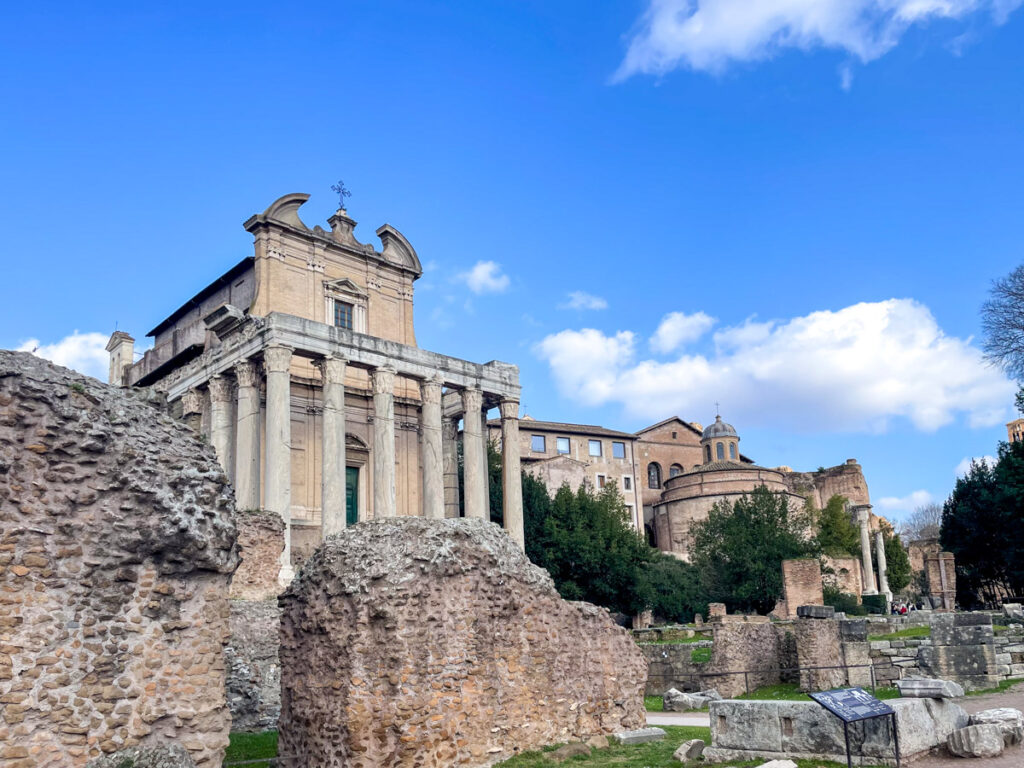
Practical Tips for the Visit
During one of my last trips to Rome, I decided to see the Colosseum again, but my experience was not very good. First, there are long queues in front of the entrance even though the tickets have a precise entry time. They only let you in ten minutes early, and people wait outside crowded together, no matter what time is printed on the ticket. When your turn comes, you have to approach past everyone because there may be people in front of you with tickets with times ten minutes later. If you arrive after the scheduled entrance time, you can no longer enter the Colosseum.
After entering the Colosseum, you must queue again to check your bags with an X-ray check like at the airport. Then, there was another queue to collect the audio guide included in the entrance ticket. Picking up the audio guide is another adventure. At the time of writing, it is not clear where to pick them up, so you have to ask the staff inside the arena to orient you. In fact, the audioguide queue is at the guided tour box on the other side of the ground floor from the entrances. The word ‘audioguides’ is very small and cannot be seen from a distance, while ‘guided tours’ is more explicit.
The official audio guide of the Colosseum
The audio guide of the Colosseum is another disappointment because it is very dated and not very understandable. Promoted as an audio-video guide, you can listen to it and watch the films from a dirty old iPod and, as happened to me, with a nearly flat battery. Along with the iPod, you are given sealed disposable earphones. To avoid waste, I recommend bringing your own headphones.
Again, the tour route is poorly signposted, and it is unclear where to click and when to start the guide’s audio at the correct point. The explanations are very simple, with no particular curiosities. If you already know the history of the Colosseum, it adds little. In my opinion, the video part of the audio guide is even worse, with clips from old costume films set in Ancient Rome. I advise you to forget the audio guide if it is not included in your entrance ticket. Invest in a tour guide that will make you better appreciate the history and architecture of the Flavian Amphitheatre.
Guided tours of the Colosseum
Taking a guided tour of the Colosseum is the best choice to appreciate this iconic building of Ancient Rome. Inside the Flavian Amphitheatre is very little information, and the audio guide is of little help. You may find yourself inside a UNESCO heritage building without knowing what you are looking at.
As one of Rome’s most visited attractions, you will find many tours inside the Colosseum Park. I recommend choosing a guided tour that includes what you want to visit, such as the underground passages, which are not included in all entrance tickets. Some examples of guided tours of the Colosseum are:
- Priority Access Colosseum, Roman Forum & Palatine Tour
- Colosseum Tour with Access to the Gladiator Arena
- Colosseum: Underground and Ancient Rome Tour
- Colosseum Underground and Arena Floor Night Tour
- Colosseum Gladiator Tour for Kids and Families
When to visit the Colosseum
The Colosseum is always crowded, including in the low season. I recommend you avoid the high season, from May to October, when it gets chaotic. Regarding visiting hours, the opening and closing times are generally less crowded but don’t expect a quiet visit. I visited in the morning in February and managed to see almost nothing.
How to dress for visiting the Colosseum
While visiting the Colosseum, Roman Forum and Palatine Hill you will walk a lot so I suggest you wear comfortable clothing and sports shoes. Moreover, the Colosseum Park, a hill with buildings on different levels, is mostly not flat and sometimes uneven and bumpy paths. During the summer, remember to bring a water bottle, hat and sunscreen to protect yourself from the sun.
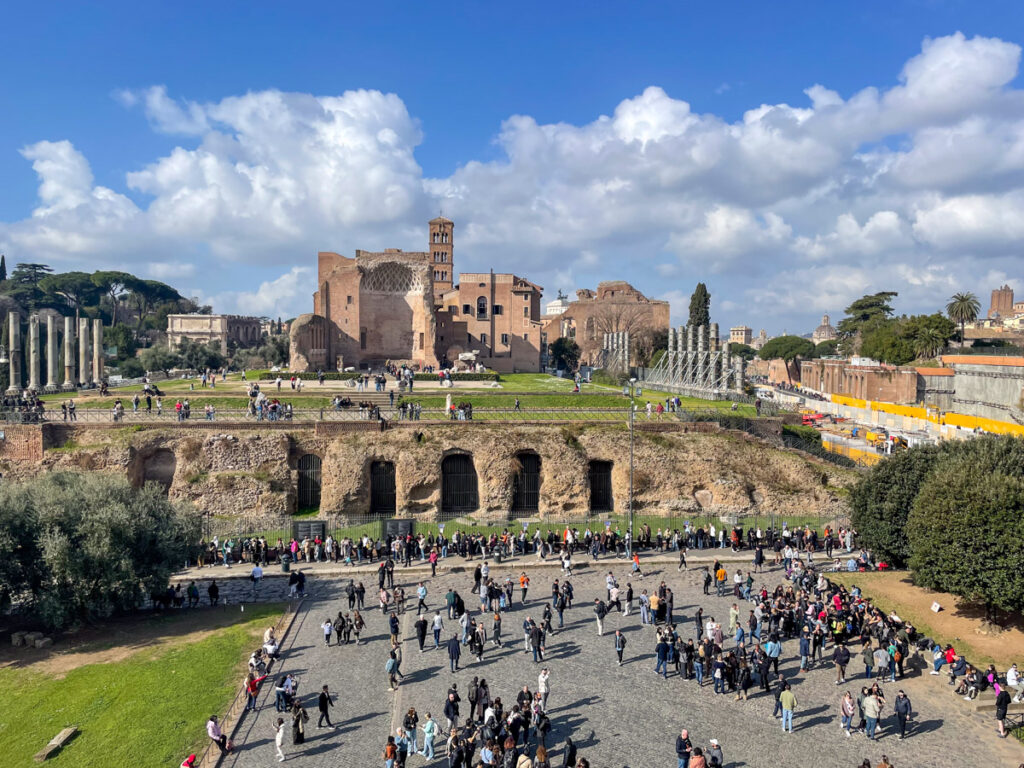
Colosseum tickets: where to buy them and which type to choose
The main problem with visiting the Colosseum is getting tickets. The official ticket office is in the square in front of the monument, near the Temple of Venus and Rome. However, tickets sell out very quickly and buying them at the official ticket office is almost impossible. Buying tickets online is practically obligatory to avoid the risk of being unable to get in.
You can buy tickets on the official website of the Colosseum Park. However, the availability is often sold out there as well. In this case, to get in, it is better to buy tickets directly on the website of specialised operators who purchase large quantities of tickets every day and then resell them at a mark-up. For this reason, you can often find tickets available on the websites of these operators, such as GetYourGuide, even when the official website is sold out, as you can see from the calendar below.
In any case, don’t wait until the last minute to buy tickets. Book them at least a week or two in advance, especially in high season. However, if you can’t find ticket availability anywhere, change your plans and don’t buy tickets from unauthorised sellers. On my last visit, they were not there after a huge police intervention, but unauthorised resellers of Colosseum tickets as well as photos with fake gladiators asking you for money are some of the most common scams against tourists in Rome.
What kind of Colosseum tickets to choose
All areas of the Colosseum are accessible to the public. However, there are different entrance tickets for each area. At the time of writing, the tickets available online are:
- 24h Ticket Colosseum, Roman Forum, Palatine
- Full Experience Ticket
- Full Experience Ticket Penthouse with panoramic lift
In the official ticket office of the Colosseum Park, you can also find other types of tickets that are not available online. For example, tickets that only include access to the Imperial Forum and the Palatine Hill, without the entrance to the Flavian Amphitheatre.
The 24h – Colosseum, Roman Forum, Palatine Hill ticket is the best-selling one, with a fixed time of entry to the Colosseum and access to the Roman Forum, Palatine Hill and Imperial Forums before or after, without a fixed time as long as it is only once during the 24 hours of validity of the ticket. Specifically, this ticket includes access to the first and second levels of the Colosseum with panoramic terraces, the Colosseum Museum, the Roman Forum, Palatine Hill, and Imperial Forums.
The Full Experience ticket, on the other hand, is valid for two consecutive days, with the same entrance with reserved time at the Colosseum and only one entrance to the area of the Palatine Hill and the Imperial Forums, with no reserved time. The main difference is that compared to the 24-hour ticket, it also includes admission to the arena, the underground and some museums in the Palatine Hill area. In addition, the Full Experience Attic ticket allows you to go up to a higher gallery of the Colosseum with the panoramic lift during the time slot from 8:30 am to 3:00 pm.
How much do Colosseum tickets cost
Tickets for the Colosseum are pretty expensive and could be a large part of your daily budget when travelling to Rome. The cost starts at €18 on the official website of the Colosseum Park, while on retailers’ sites, it costs an average of €35. Roma Pass holders get a reduced ticket, while children and young people under 18 do not pay.
Where to stay in Rome
I have tried several hotels in Rome during my travels and I recommend staying in the city centre to avoid the chaotic traffic of the capital. Among the hotels I suggest, the charming Roma Suites Navona has family rooms and is in a great location just a few steps from Piazza Navona.
If you prefer a hotel with a buffet breakfast, you can choose the Bloom Hotel Rome, very close to St Peter’s Basilica, while if you arrive by train, the best choice near Termini station is the DoubleTree By Hilton Rome Monti hotel with double and family rooms.
Despite the crowds and the costs, visiting the Colosseum, the largest amphitheatre of Ancient Rome, now a UNESCO World Heritage Site, remains a unique experience. Write to me in the comments if you feel the same or had to give up the visit because of difficulty finding tickets.
